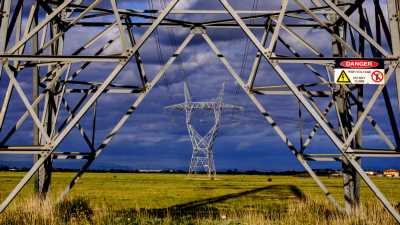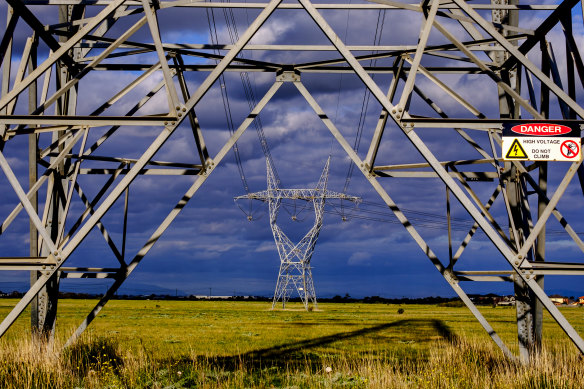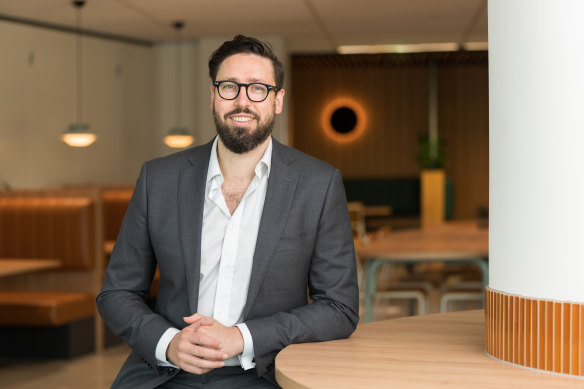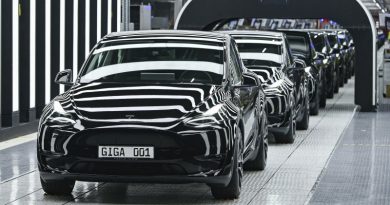AusNet chief confident grid will be ready for coal’s exit
Save articles for later
Add articles to your saved list and come back to them any time.
Power grid operator AusNet is confident a vast expansion of the transmission network can be delivered in time to connect enough wind and solar farms to compensate for coal-fired power plants’ closures, even as intense community opposition looms as a major obstacle.
Australia is experiencing one of the world’s fastest energy transitions as coal-fired power plants, which supply about two-thirds of the eastern seaboard’s electricity grid, are being retired while clean energy’s share of the power mix continues to grow.
New high-voltage transmission lines are needed to expand the grid to reach more renewables and achieve the Albanese government’s target for 82 per cent of Australia’s power being green by 2030.Credit: Luis Ascui
However, energy companies and authorities are growing nervous about the lagging rollout of new high-voltage transmission lines needed to expand the grid to reach more renewables and achieve the Albanese government’s target for 82 per cent of Australia’s power being green by 2030.
The delays are being partly driven by significant local opposition against key projects to modernise the grid, including AusNet’s Western Renewables Link, as communities voice concerns about the impact of giant towers and overhead power lines on their properties and on the landscape and the environment.
AusNet chief development officer Jon D’Sylva, who came into the role six months ago, said he recognised the genuine concerns of affected people, many of whom were multi-generational farmers. He acknowledged that AusNet had failed to ensure an adequate level of community engagement when the project was conceived.
“At the state and national levels, there is huge support to get towards net-zero [emissions], but then you get to the local impact and there is a real sense of, ‘Why do I have to pay the price for other Australians?’. It’s a really genuine concern,” he said.
AusNet chief development officer Jon D’Sylva: “It is important to go and talk to the communities.”
“Before you go and even announce a project, it is important to go and talk to the communities, have fact sheets ready, understand any concerns they might have but I think everyone acknowledges that it wasn’t set up right from the start, and there have been lessons learned.”
Western Renewables Link, a 190 kilometre transmission project from Bulgana near Stawell to Sydenham in Melbourne’s north, aims to tap the renewable energy being generated by wind farms in western Victoria and transport it to Melbourne.
Since AusNet, the Victorian transmission network operator, was awarded the tender in 2019, it has confronted large-scale community protests by landholders from suburban Melton to potato farming areas near Daylesford, who say it will affect their livelihoods. They want the power lines rerouted or buried, which would add to the costs that would be passed onto retail customers.
D’Sylva said AusNet was heavily invested in seeking to rebuild trust across affected communities, and he believed it was seeing encouraging signs of progress.
”Once you start behind the eight ball, it’s a little hard to catch up,” he said. “We are doing a lot of work to make sure we get the social licence right in all the communities we work with.“
Following the closure of AGL’s Liddell coal-fired power plant in NSW earlier this year, at least four more coal plants in Victoria, NSW and Queensland are expected to shut down by 2030.
Australian Energy Market Operator chief executive Daniel Westerman, who oversees the nation’s power and gas systems, has been saying the build-out of new generation, storage and transmission lines is happening too slowly to ensure continuous, reliable and affordable electricity supply after coal plants retire.
Transmission links joining the eastern states’ power grids were already “maxing out”, he said, while massive volumes of solar and wind power were having to be curtailed because there was not enough transmission capacity to transport it.
D’Sylva acknowledged there was a “bit of pressure” surrounding the government’s 2030 renewables target, but he said it remained achievable, and AusNet was optimistic Australia could manage the transition.
For the plan to work, industry players and governments would need to “get a wriggle on” in developing or making significant progress on the construction of multiple new transmission links to harness energy from rich wind and solar regions, which are often located far from existing grid infrastructure, he said.
“From our side, we are absolutely committed to building out what’s required,” D’Sylva said.
“We’ve known it’s been needed, but the urgency has just ramped up unbelievably over the last year or so – and what’s been driving that is the retirement of these large coal generators.”
Westerman implored transmission developers and local stakeholders not to fall into an “us versus them” dichotomy, but stressed that communities being asked to host new power poles and wires deserved to be treated and compensated fairly.
“Communities expect the energy industry to be open with them: no hidden agendas, to explain clearly the situation, not hide behind obscure technical language, to listen, to respond thoughtfully and meaningfully, and to fairly compensate those affected,” he said.
The Business Briefing newsletter delivers major stories, exclusive coverage and expert opinion. Sign up to get it every weekday morning.
Most Viewed in Business
From our partners
Source: Read Full Article




